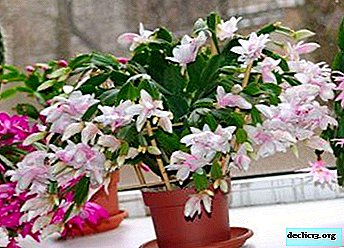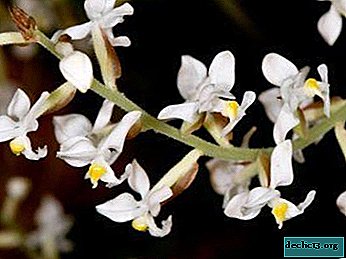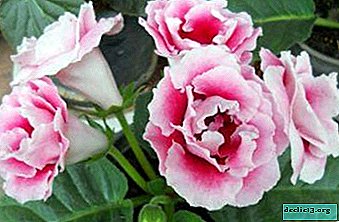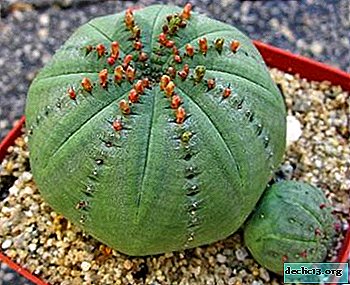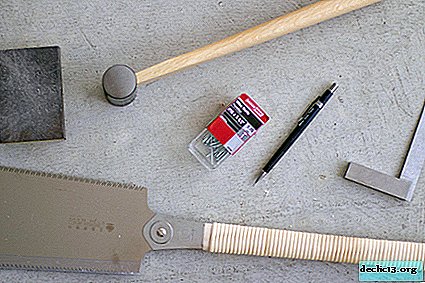A detailed description of the cultivation of fuchsia and its care
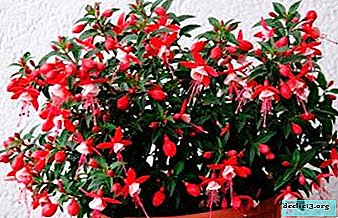
Fuchsia, a small bush with bright bizarre flowers, can be grown both at home and in the open ground. But it should be borne in mind that each of the methods has its own characteristics.
We will learn from the article how to properly care for a houseplant in order to achieve active flowering, as well as what conditions must be provided for fuchsias grown in open ground. In addition, we will find out how this flowering plant propagates and what diseases and pests are most dangerous for it.
Pot selection
Fuchsia can be grown in an ordinary or hanging pot. Do not immediately use a large diameter pot, it is necessary to change the size gradually. If the roots of the plant are braided by a lump of soil or are shown from the drainage holes of the pot, then by transshipment or transplantation, fuchsia should be placed in a container 3 cm larger in diameter than the existing one.
Tip. Fuchsia develops well in plastic pots with large drainage holes. Moreover, it is recommended to use containers of light shades due to the fact that dark pots heat up faster in hot sunny weather, and the delicate roots of fuchsia can suffer.You can use clay pots, given the following points:
- rapid heating of the clay pot in hot weather will require more frequent watering of the plant;
- placing a clay pot on a cool window sill in winter, combined with a violation of the watering regime, can lead to rotting of the bush.
Seed propagation
Priming
To properly grow fuchsia from seeds, you need to use special soil purchased in a specialized store. It is permissible to independently produce a suitable mixture of turf land, peat and sand in a ratio of 3: 2: 1.
 It is convenient to use peat tablets for germination - this allows subsequently replanting the sprouts without disturbing the delicate root system of plants.
It is convenient to use peat tablets for germination - this allows subsequently replanting the sprouts without disturbing the delicate root system of plants.
Mandatory soil properties are:
- moisture permeability;
- nutrient saturation;
- water permeability;
- sterility.
For planting, you should have a container with a pallet in which seeds and individual pots will be placed for further transplantation of sprouts.
Preparation and germination
For fuchsia, seeds can be purchased at the store. BUT in the presence of adult fuchsia, seeds can be obtained independently. This will require the following steps:
- remove anthers from unbroken buds of the mother bush with tweezers;
- with a brush, remove pollen from the father’s bush and apply on the mother’s pestle;
- cover the pollinated bud with a thin cloth;
- after the appearance of the berry, remove the tissue;
- remove the ripened fruit, extract and dry the seeds;
- Store seeds in a cool place until spring.
Sprout seeds in February or March.
Before sowing, the prepared soil must be moistened with water with the addition of a weak solution of potassium permanganate and compacted. Seeds do not fall asleep, but only crush. This condition is necessary because Fuchsia seeds do not sprout without access to light. If peat tablets are used, then one fuchsia seed is placed in one tablet enlarged after soaking.
How to care: watering, temperature, humidity, lighting
A container with seeds, closed with a film or glass, is placed in a bright and warm place with a temperature of 18 to 20 degrees.
It is necessary to monitor the humidity regime and remove the film or glass in time in order to ventilate in the presence of condensate.
 3-4 weeks after the appearance of sprouts, the airing time gradually increases. When the sprout gives a second pair of leaves, it should be transplanted into a separate pot. To do this, the dug sprout is lowered into shallow holes prepared in the pot in advance and the earth around it is pressed tightly. For a couple of days you can close the sprout in the pot with a film.
3-4 weeks after the appearance of sprouts, the airing time gradually increases. When the sprout gives a second pair of leaves, it should be transplanted into a separate pot. To do this, the dug sprout is lowered into shallow holes prepared in the pot in advance and the earth around it is pressed tightly. For a couple of days you can close the sprout in the pot with a film.
Watering should be done through a pan or along the edge of the pot, making sure that watering does not occur before the soil dries. Once every two weeks you need to feed young fuchsias with complex mineral fertilizer. After the growth of the bushes exceeds 10 cm, you need to pinch the tops.
You can find out how to care for fuchsia at home here.
Features
Usually fuchsia is propagated by cuttings. Germination of seeds is used, as a rule, for breeding purposes - the resulting plants may not have maternal features at all. Fuchsia seeds do not hold steady germination for long, it is best to use them immediately after purchase or self-receipt.
Details about what is best - to grow fuchsia yourself or buy an adult flower in a store, as well as how to plant a plant better - with seeds or cuttings, read in this material.
Garden plant
Earth and fertilizer
Fuchsia develops well in bright, windless places, preferring fertile neutral soils. The place chosen for landing should not be exposed to strong winds.
Note! Some gardeners bury the plant in the ground directly in the pot. So they ensure the stability of the bush, which also will not need frequent watering.For the winter, the bushes are dug up and placed in a cool, bright room. until the next summer season (how to save fuchsia in the winter in the basement and in the apartment can be found here). Before this, it is allowed to trim the plant. Some varieties of fuchsia are left for the winter under the snow (for example, Magellan fuchsia). In this case, the plant is cut to ground level, covered with a layer of soil about 20 cm, a spruce is placed on top, followed by a layer of film. Discover fuchsia begin no earlier than mid-May.
Seedlings
Planting on open soil is carried out at the end of May. To do this, you can use seeds sprouted in a container, shoots rooted in water or a liquid substrate, or overwintered fuchsia bushes. In the latter case, the plant must be awakened from rest by transplanting fuchsia into a new soil and increasing watering.
How to form a bush?
To form the crown of fuchsia, the plant needs regular pruning. All lateral shoots after the third pair of leaves should be pinched. This should be done until the time of flowering. A systematic removal of all wilted or damaged flowers and weak shoots is also required.
Follow-up care
- The temperature regime for fuchsia should be maintained in the range from 18 to 25 degrees. The plant should be protected from direct sunlight in hot weather, their effect leads to the drying of the bush. In addition, temperature violations increase the risk of fuchsia and plant damage by pests.
- Fuchsia loves bright but diffused light. When planting in open ground, it is better to place it in partial shade (we talked about the features of fuchsia care in the garden here). For home fuchsia, eastern or western windows are suitable. When placed on the north window, additional lighting should be provided.
Attention! During flowering, it is not recommended to turn over or rearrange the bush, because fuchsia can throw off flowers.
- Water the plant should be when the topsoil is dried. Before use for watering, it is better to let the water settle. Closer to the winter period, the intensity of irrigation should be gradually reduced. It is permissible to water fuchsia during the rest period about two times a month.
- In summer, the leaves of the plant need to be sprayed a couple of times a day with water, at other times of the year it is not necessary.
- Biological fertilizers are used for fuchsia in open ground., home plants need specialized top dressing for indoor flowering plants. You need to feed fuchsia once a week, excluding the winter period, in which top dressing is not needed.
- To accelerate the growth of green mass, the use of fertilizers with a high nitrogen content is required. Potassium and phosphorus mixtures will support flowering.
- Fuchsia bush in spring needs a transplant. Before this procedure, it is necessary to trim the shoots. After transplanting, do not feed for 4 weeks.

You can read about how care for fuchsia should be, as well as get tips on keeping a flower at home, here.
Possible diseases
- Yellow leaves of fuchsia can be a sign of chlorosis - a consequence of a violation of the irrigation regime or a lack of nitrogen or magnesium in the soil.
- If the bush has slowed down in growth, and a yellow tint is observed between the leaf veins, this may indicate a lack of molybdenum.
 In the cases described, the conditions for the maintenance of fuchsia should be reviewed., including its periodic top dressing.
In the cases described, the conditions for the maintenance of fuchsia should be reviewed., including its periodic top dressing.
- Healthy fuchsia has white roots. If the roots darkened, became brown, then due to excessive watering the plant was struck by brown rot. In most cases, fuchsia cannot be saved.
- If brown concentric circles are seen on the underside of the sheet, it is necessary to remove all affected elements of the plant as soon as possible. This rust is an infectious disease that can be easily transmitted to healthy bushes. To cure, the use of a fungicide solution is necessary.
Fuchsia has long and firmly taken a place in the hearts of flower growers. Growing this luxurious flower is possible both at home and on the open ground. To create the conditions necessary for the plant, a systematic allocation of time will be required, but this will guarantee that there are no serious problems when growing fuchsia.
Useful video
When and how to transplant fuchsia, do you need a pinch and how to do it correctly in order to form a beautiful plant, what should be the optimal temperature of the content - we learn about this from the video:


